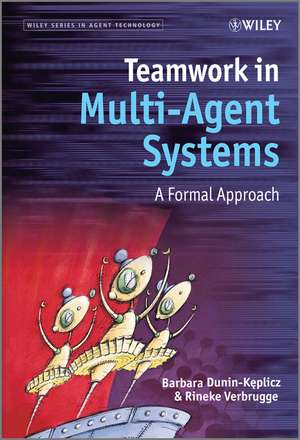Teamwork in Multi–Agent Systems – A Formal Approach: Wiley Series in Agent Technology
Autor BM Dunin–Kepliczen Limba Engleză Hardback – 3 iun 2010
Preț: 470.15 lei
Preț vechi: 675.13 lei
-30% Nou
Puncte Express: 705
Preț estimativ în valută:
89.96€ • 94.17$ • 74.88£
89.96€ • 94.17$ • 74.88£
Carte indisponibilă temporar
Doresc să fiu notificat când acest titlu va fi disponibil:
Se trimite...
Preluare comenzi: 021 569.72.76
Specificații
ISBN-13: 9780470699881
ISBN-10: 0470699884
Pagini: 244
Dimensiuni: 249 x 171 x 20 mm
Greutate: 0.59 kg
Editura: Wiley
Seria Wiley Series in Agent Technology
Locul publicării:Chichester, United Kingdom
ISBN-10: 0470699884
Pagini: 244
Dimensiuni: 249 x 171 x 20 mm
Greutate: 0.59 kg
Editura: Wiley
Seria Wiley Series in Agent Technology
Locul publicării:Chichester, United Kingdom
Public țintă
Students and researchers in computer science, in particular artificial intelligence, software engineering and multi–agent systems, developers of multi–agent systems, and systems for computer–supported cooperative workCuprins
About the Authors. Foreword. Preface. 1 Teamwork in Multi-Agent Environments. 1.1 Autonomous Agents. 1.2 Multi-Agent Environments as a Pinnacle of Interdisciplinarity. 1.3 Why Teams of Agents? 1.4 The Many Flavors of Cooperation. 1.5 Agents with Beliefs, Goals and Intentions. 1.6 From Individuals to Groups. 1.7 Group Attitudes. 1.8 A Logical View on Teamwork: TEAMLOG. 1.9 Teamwork in Times of Change. 1.10 Our Agents are Planners. 1.11 Temporal or Dynamic? 1.12 From Real-World Data to Teamwork. 1.13 How Complex are Models of Teamwork? 2 Beliefs in Groups. 2.1 Awareness is a Vital Ingredient of Teamwork. 2.2 Perception and Beliefs. 2.3 Language and Models for Beliefs. 2.4 Axioms for Beliefs. 2.5 Axioms for Knowledge. 2.6 Relations between Knowledge and Belief. 2.7 Levels of Agents' Awareness. 3 Collective Intentions. 3.1 Intentions in Practical Reasoning. 3.2 Language and Models for Goals and Intentions. 3.3 Goals and Intentions of Individual Agents. 3.4 Collective Intention Constitutes a Group. 3.5 Definitions of Mutual and Collective Intentions. 3.6 Collective Intention as an Infinitary Concept. 3.7 Alternative Definitions. 3.8 The Logic of Mutual Intention TeamLogmint is Complete. 3.9 Related Approaches to Intentions in a Group. 4 A Tuning Machine for Collective Commitments. 4.1 Collective Commitment. 4.2 The Language and Kripke Semantics. 4.3 Building Collective Commitments. 4.4 Tuning Collective Commitments. 4.5 Different Notions of Collective Commitment. 4.6 Topologies and Group Commitments. 4.7 Summing up TeamLog: The Static Part of the Story. 5 Reconfiguration in a Dynamic Environment. 5.1 Dealing with Dynamics. 5.2 The Four Stages of Teamwork. 5.3 The Reconfiguration Method. 5.4 Case Study of Teamwork: Theorem Proving. 6 The Evolution of Commitments during Reconfiguration. 6.1 A Formal View on Commitment Change. 6.2 Individual Actions and Social Plan Expressions. 6.3 Kripke Models. 6.4 Dynamic Description of Teamwork. 6.5 Evolution of Commitments During Reconfiguration. 6.6 TeamLog Summary. 7 A Case Study in Environmental Disaster Management. 7.1 A Bridge from Theory to Practice. 7.2 The Case Study: Ecological Disasters. 7.3 Global Plans. 7.4 Adjusting the TeamLog Definitions to the Case Study. 7.5 Conclusion. 8 Dialogue in Teamwork. 8.1 Dialogue as a Synthesis of Three Formalisms. 8.2 Dialogue Theory and Dialogue Types. 8.3 Zooming in on Vital Aspects of Dialogue. 8.4 Information Seeking During Potential Recognition. 8.5 Persuasion During Team Formation. 8.6 Deliberation During Planning. 8.7 Dialogues During Team Action. 8.8 Discussion. 9 Complexity of Teamlog. 9.1 Computational Complexity. 9.2 Logical Background. 9.3 Complexity of TeamLogind. 9.4 Complexity of the System TeamLog. 9.5 Discussion and Conclusions. A Appendix A. A.1 Axiom Systems. A.2 An Alternative Logical Framework for Dynamics of Teamwork: Computation Tree Logic. Bibliography. Index.






